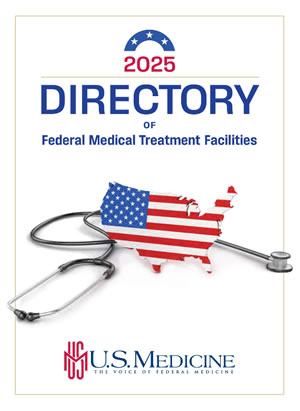 BOSTON — VHA facilities across the United States have experienced a concerning rise in antibiotic resistance to third-generation cephalosporins, a class of broad-spectrum antibiotics commonly used to treat the Enterobacterales bacterial species. The alarming trend necessitates enhanced surveillance and action, according to a recent study.
BOSTON — VHA facilities across the United States have experienced a concerning rise in antibiotic resistance to third-generation cephalosporins, a class of broad-spectrum antibiotics commonly used to treat the Enterobacterales bacterial species. The alarming trend necessitates enhanced surveillance and action, according to a recent study.
The nationwide retrospective cohort study published in The Lancet Infectious Diseases aimed to analyze trends in inpatient infection incidence and antimicrobial resistance for nine pathogens over the past 15 years across the U.S.1
The study authors are affiliated with the Harvard T.H. Chan School of Public Health in Boston; VA Salt Lake City Health Care System; and University of Utah in Salt Lake City.
Antimicrobial resistance “poses a major threat to public health, but long-term surveillance data on clinical infection incidence and antimicrobial resistance trends across multiple pathogens and multiple locations are scarce. The VAHS, as the largest integrated healthcare system in the U.S., provides a unique and comprehensive source of routinely collected microbiology data spanning 15 years, which includes data from 13 years before the COVID-19 pandemic and two years during the pandemic covering all census regions in the U.S.,” lead author Thi Mui Pham, PhD, a research associate at Harvard T.H. Chan School of Public Health, told U.S. Medicine.
“The scale of this dataset, combined with the diversity of hospital-associated pathogens observed in the system, offers a valuable opportunity to study infection patterns and resistance trends over time,” Pham said.
In this study, the authors analyzed clinical microbiology data from electronic health records from all patients admitted to all VAMCs with acute-care wards (138 medical centers total) across the United States from Feb. 1, 2007, to March 31, 2022. They quantified inpatient antibiotic use as days of therapy per 1,000 patient-days and antimicrobial resistance by resistance proportion (proportion of incident isolates identified as resistant) and phenotypic incidence (incidence of infections per 1,000 admissions classified as resistant, susceptible or missing). They collected 991,527 30-day incident isolates from 507,760 patients in 138 VAMCs and 50 states in the U.S., the study reported.
The authors focused on nine pathogens: Staphylococcus aureus, Enterococcus faecium, Enterococcus faecalis, Acinetobacter sp, Pseudomonas aeruginosa, Serratia marcescens, Enterobacter cloacae, Escherichia coli and Klebsiella pneumoniae, representing a range of pathogens commonly associated with healthcare-associated and community-acquired infections and multidrug resistance. They calculated the incidence of infection by species and assessed trends in antimicrobial resistance using both the proportion resistant and phenotypic incidence rate (number of susceptible, resistant and missing susceptibility test results per 1,000 admissions) over time, according to the study.
For each pathogen, the analysis discovered “a trend of declining incidence of hospital-associated infections from 2007 to 2019, but trends in the incidence of community-onset infections varied across pathogens. The decrease in hospital-associated infections accounted for an overall reduction of infection incidence from 2007 to 2019, and during the COVID-19 pandemic in 2020, incidence rose, particularly for hospital-associated infections,” the authors explained.
Also, the study determined that “resistance proportions between 2007 and 2019 declined for many, but not all, pathogen-drug combinations. A consistent finding for all nine species was a decrease in fluoroquinolone resistance proportions between 2007 and 2019.”
“Our study confirmed ongoing reductions in methicillin resistance in S. aureus and vancomycin resistance in E. faecium,” Pham said. “A particularly striking finding was the significant and sustained decline in both the incidence of healthcare-associated infections and the proportion and incidence of fluoroquinolone resistance across nearly all species studied, particularly prior to the COVID-19 pandemic (2007-2019).”
“This decline was also associated with a significant reduction in fluoroquinolone prescribing, suggesting the effectiveness of infection control and antimicrobial stewardship efforts,” she added. “However, we also observed an increase in third-generation cephalosporin resistance for Enterobacterales species. During the pandemic years (2020-22), we observed a concerning increase in resistance proportions for several pathogen-drug combinations in healthcare-associated infections, reversing some of the progress made in earlier years.”
This study “highlights how individual clinical decisions (whether to prescribe antibiotics and which antibiotics to prescribe) may cumulatively impact resistance trends within a population over time,” Pham suggested.
“The findings underscore the critical value of coupling data on resistance proportions (the percentage of resistant isolates) with phenotypic incidence (the number of resistant infections per population per unit time) to accurately assess and interpret antibiotic resistance burden and trends,” Pham said. “For example, an increase in resistance proportion does not reveal whether that is due to an increase in the incidence of resistant infections, a decline in the incidence of susceptible infections or both. We hope that the adoption of both measures will become the new standard in reporting, ultimately aiding decision-making in healthcare settings and improving public health strategies.”
The authors would like “healthcare professionals to recognize that, while some resistance trends are improving, others, such as the rise in extended-spectrum beta-lactamase-producing Enterobacterales and healthcare-associated infections during the OVID-19 pandemic, are concerning,” she explained.
“These trends warrant caution in prescribing antibiotics, particularly third-generation cephalosporins and carbapenems,” Pham asserted. “Continuous adaptation of infection control measures and stewardship interventions, as well as ongoing surveillance of antimicrobial resistance remain essential. Our study provides a comprehensive view of the antimicrobial landscape in the U.S. However, it is also important to monitor and understand local epidemiological patterns.”
Broad-spectrum carbapenems were the most commonly used therapy for targeted treatment of extended-spectrum cephalosporin-resistant (ECR) Enterobacterales infections in U.S. hospitals, according to a retrospective cohort study published recently in the same publication.2
- Pham TM, Zhang Y, Nevers M, Li H, Khader K, Grad YH, Lipsitch M, Samore M. Trends in infection incidence and antimicrobial resistance in the US Veterans Affairs Healthcare System: a nationwide retrospective cohort study (2007-22). Lancet Infect Dis. 2024 Aug 13:S1473-3099(24)00416-X. doi: 10.1016/S1473-3099(24)00416-X. Epub ahead of print. PMID: 39151443.
- Walker MK, Diao G, Warner S, Babiker A, Neupane M, Strich JR, Yek C, Kadri SS; National Institutes of Health Antimicrobial Resistance Outcomes Research Initiative (NIH–ARORI). Carbapenem use in extended-spectrum cephalosporin-resistant Enterobacterales infections in US hospitals and influence of IDSA guidance: a retrospective cohort study. Lancet Infect Dis. 2024 Aug;24(8):856-867. doi: 10.1016/S1473-3099(24)00149-X. Epub 2024 Apr 25. PMID: 38679036; PMCID: PMC11283355.

